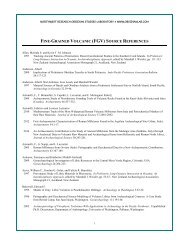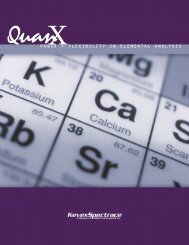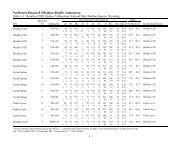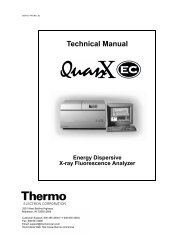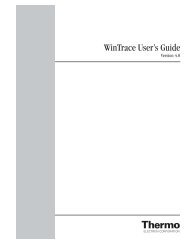arl quant'x - Northwest Research Obsidian Laboratory
arl quant'x - Northwest Research Obsidian Laboratory
arl quant'x - Northwest Research Obsidian Laboratory
Create successful ePaper yourself
Turn your PDF publications into a flip-book with our unique Google optimized e-Paper software.
e l e m e n t a l a n a l y s i s<br />
Thermo Scientific ARL QUANT’X<br />
Energy-Dispersive XRF<br />
Spectrometer<br />
Part of Thermo Fisher Scientific<br />
Analysis without Compromises<br />
Aerosol Particulate Filters<br />
RoHS and WEEE Screening<br />
Forensics and Investigation<br />
Food and Consumer Safety<br />
Oils, Lubricants and Wear Metals<br />
Metallurgical Slags and Mining Ores<br />
Cement, Feed and Alternative Fuels<br />
Semiconductor and Magnetic Media
Thermo Scientific ARL QUANT’X<br />
Energy-Dispersive XRF Spectrometer<br />
ARL QUANT’X<br />
The peak of EDXRF performance<br />
The Thermo Scientific ARL QUANT'X Energy-Dispersive X-ray<br />
Fluorescence spectrometer is a state-of-the-art elemental analyzer for<br />
the most challenging analytical tasks in research and manufacturing.<br />
Look inside the cast metal full-vacuum sample chamber on a welded<br />
anodized frame, and you’ll know the ARL QUANT’X is built to last.<br />
The high-intensity filtered X-ray beam and the most powerful and<br />
reliable X-ray detector ever designed provide the highest speed,<br />
sensitivity and flexibility.<br />
Any analyst can finally take advantage of:<br />
• Rapid elemental analysis from Na to U<br />
• Sensitivity from
Thermo Scientific ARL QUANT’X<br />
Energy-Dispersive XRF Spectrometer<br />
Exclusive technology inside the Si(Li)<br />
When it comes to performance, quality and reliability, the latest trend to hit the street isn’t always the best<br />
choice. After 25 years and 4 generations of technical innovation, the Silicon Lithium-Drifted Si(Li) detector<br />
technology at the heart of the ARL QUANT’X continues to set the standard for sensitivity, speed and<br />
reliability. As a leading X-ray detector manufacturer for 40 years, our company knows the key parameters<br />
that define a detector’s performance.<br />
Crystal Area<br />
Analysis of small samples, thin deposits or low<br />
concentrations is typically limited by the power of<br />
the X-ray tube and requires efficient capture of low<br />
fluoresced intensities from the sample. Larger<br />
crystal area effectively amplifies X-ray tube power.<br />
The Si(Li) crystal area is up to 5x larger than other<br />
models and provides a larger “umbrella” for<br />
capturing photons. This is one of the main reasons<br />
why the ARL QUANT'X can achieve sub-nanogram<br />
sensitivity in a compact bench-top package.<br />
Crystal Temperature<br />
Lower operating temperature dramatically reduces<br />
electronic noise, improves resolution, reliability<br />
and makes the instrument less sensitive to<br />
environmental variations. Thermo Scientific<br />
advanced six-stage Peltier coolers can attain<br />
-100 °C versus simpler models that operate at<br />
-15 to -25 °C. Thanks to cutting edge engineering,<br />
the performance of electrically-cooled detectors<br />
is now equivalent to that of conventional liquidnitrogen<br />
(LN) designs.<br />
Crystal Thickness<br />
The nature of X-rays is to penetrate matter. Highenergy<br />
X-rays emitted by atoms such as Mo, Ag or<br />
Cd can slice through Silicon like a hot knife through<br />
butter, so a thick crystal is required to capture them<br />
effectively and prevent damage to sensitive<br />
components behind the crystal. The Si(Li) crystal is<br />
10x thicker than other models.<br />
The thin Silicon crystals found in PIN and SDD<br />
detector types show a dramatic drop in efficiency<br />
for higher-energy fluorescence as illustrated here.<br />
For this reason, they should be used primarily for<br />
light-element, low-energy analysis.
Just Say GO!<br />
WinTrace software for the ARL QUANT’X opens the door to the limitless inherent flexibility of EDXRF, drawing<br />
on advanced algorithms and practices perfected through decades of research and experience. Collect and<br />
process up to eight filtered spectra per sample for any number of analytes, apply any one of seven analytical<br />
algorithms and include as many or as few calibration standards as you want. Once collected, spectra can<br />
always be reprocessed and recalculated off-line - anywhere. And automatic X-ray power adjustment guarantees<br />
that any sample – be it air filter, slag, metal, oil or rock – will be analyzed using its own unique optimal setting.<br />
Click GO and analyze anything in 3 clicks!<br />
Intuitive<br />
Add or remove elements simply by clicking on a periodic table.<br />
Review calibrations and results using a Tree-type interface. Build<br />
your own methods from templates for common applications.<br />
Simple and User-friendly<br />
Organize your desktop environment with shortcuts that take you<br />
directly to key analytical tasks.<br />
In today’s computer-controlled world, even the most advanced<br />
hardware would be handicapped without flexible software<br />
designed to take full advantage of it. The Method Explorer<br />
interface provides advanced users with access to every<br />
parameter to obtain the highest throughput, sensitivity and<br />
selectivity in any application:<br />
� Any X-ray voltage from 4 kV to 50 kV in 1 kV steps<br />
� Eight primary filters for optimal background control<br />
� The atmosphere and analysis time, per spectrum<br />
� Detector resolution and count-rate for optimal speed<br />
� Interactive excitation guide for each user selection<br />
Secure<br />
Password-protection in all critical areas of the software assures the<br />
security of your methods and data. Operators are only allowed to<br />
specify sample names, positions and click GO.<br />
Flexible<br />
Accurate extraction of peak intensities from the spectra is a critical<br />
first step for any quantitative analysis. Automatic deconvolution<br />
settings work for most application and can be easily customized for<br />
the most difficult cases.<br />
Fundamental Parameters<br />
The standard FP algorithms for the ARL QUANT'X work with any<br />
number of elements, standards, sample types, and excitation<br />
conditions. The software corrects for compound stoichiometry,<br />
specified concentrations and unanalyzed compounds. All equations<br />
are recalculated instantly for every sample with accuracy that rivals<br />
that of many standard certificates. Thermo Scientific FP has been<br />
used to analyze the most difficult and unpredictable samples.<br />
UniQuant ® Advanced Standard-less Analysis<br />
Going farther than any other FP analysis, the UniQuant method uses all<br />
eight filters to collect all emission lines of all possible elements from<br />
Fluorine to Uranium. This complete spectral profile of the sample allows<br />
UniQuant to automatically correct for all possible overlap and background<br />
effects, which are especially complex in energy-dispersive spectra.<br />
• All elements are always analyzed, so you’ll never need to add<br />
potential analytes.<br />
• Each sample’s unique physical properties, i.e. area, height, and<br />
mass are included in the calculation.<br />
• Long-term changes in X-ray tube output are corrected using<br />
provided monitor samples.<br />
• A variety of selectable reporting levels and formats present the<br />
results cle<strong>arl</strong>y for any type of user.<br />
• UniQuant comes completely pre-calibrated and ready to analyze<br />
anything right out of the box.
Thermo Scientific ARL QUANT’X<br />
Energy-Dispersive XRF Spectrometer<br />
The Sample Chamber<br />
Improve your productivity and extend the analytical benefits of laboratory-grade XRF to a wider range of<br />
samples with the large sample chamber and multiple sample automation and presentation options. Modular<br />
instrument design allows any sample handling option to be added or removed easily as the application changes.<br />
Auto-Samplers<br />
Automated 10- and 20-sample carousels are designed for standard powder and liquid cups,<br />
pressed pellets, as well as aerosol or sediment filters. A sample spinner is available to<br />
assure representative results for samples of questionable uniformity.<br />
Beam Collimators<br />
Beam size can be adjusted from 15 mm for rapid screening<br />
down to 1 mm for research and investigative work.<br />
Atmosphere<br />
Vacuum and helium help improve sensitivity for light<br />
elements in solid, powder and liquid samples. The inert<br />
gas flush can be used with corrosive or unstable materials.<br />
Specialized Stages<br />
Automated multi-point analysis of industry-specific samples<br />
such as hard disks and silicon wafers can be performed<br />
with specialized stages.<br />
Large Samples<br />
The single-sample tray and the special large-sample deck can accept odd,<br />
large and irregular samples, as long as they fit inside the chamber.<br />
Chamber Extension<br />
Even the largest of samples, such as cinder blocks, boots, turbine fragments, automotive<br />
parts and any sample up to 37 cm (14.6 in) high can be analyzed for semi-quantitative<br />
results without additional effort or preparation. This option helps combine the sampling<br />
advantages of hand-held XRF and the sensitivity of a laboratory analyzer. It is an ideal<br />
choice for university, forensic, museum, anthropological, military and contract laboratories.<br />
With a CCD camera for sample imaging and adjustable X-ray<br />
beam diameter, the ARL QUANT’X opens an entirely new field of<br />
EDXRF, best described as “milli” XRF. For the first time, if you can<br />
see it – you can analyze it! The ARL QUANT'X combines all the<br />
analytical features, selectivity and sensitivity of a “bulk-analysis“<br />
spectrometer with the sampling flexibility typically found in<br />
“micro” analyzers. Add another exciting dimension to your results:<br />
� Visualize and locate sample before or during analysis<br />
� Identify, isolate, and align small samples or features<br />
� Improve accuracy of qualitative and quantitative analysis<br />
� Effective spatial resolution down to 0.1 mm<br />
� LED's provide illumination inside sample chamber<br />
� Works in air, vacuum or helium environments
Technical Specifications<br />
X-ray Generator<br />
Tube Target: Rh standard, Ag optional<br />
X-ray Power: 50 W maximum<br />
Voltage Range: 4-50 kV in 1 kV steps<br />
Current Range: 0.02-1.98 mA in 0.02 mA steps<br />
Cooling: Air-cooled<br />
Selectivity: 7 filters + direct excitation<br />
Beam Size: 1.0 mm – 8.8 mm, user adjustable<br />
Basic Performance<br />
Stability: < 0.3 % rsd over 8 hours<br />
Sensitivity: < 3 ppm for Fe and Pb in Conostan S12<br />
Stray Lines: < 0.015 % med eV, < 0.05 % high eV<br />
Repeatability: < 0.3 % rsd at 1 million counts<br />
Sample Chamber<br />
Sample Size: 30.0 cm x 40.0 cm x 5.0 cm maximum<br />
Extension 1: 20.0 cm max. sample height<br />
Extension 2: 36.0 cm max. sample height<br />
Atmosphere: Air, Vacuum and Helium option<br />
Sample holder: 1-sample stage and large deck<br />
Auto-samplers: 10- and 20-position sample trays<br />
Special Stages: R-Theta (disk) and Y-Theta (wafer)<br />
Sample Imaging: CCD Camera, VGA resolution<br />
Sample-spinner: Available, software-controlled<br />
Helium Flush: 15-65 psig input, 2.4 liters/min max.<br />
Radiation and Electrical Safety<br />
Interlocks: Chamber lid (dual, separate circuits),<br />
X-ray tube, detector, warning light,<br />
side panels. Fail-safe circuit design.<br />
Radiation: < 0.25 mR/hr at a distance of 2 inches<br />
Sound: < 65 dbA at a distance of 1 meter<br />
Compliance: TÜV, UL, CE, GS<br />
Computer and Software<br />
PC Platform: Laptop or Desktop computer<br />
Processor: Intel-based Pentium 4, 2.8 GHz<br />
Memory: 1 Gb RAM, 40 Gb hard drive<br />
Communication: Ethernet (2 ports), USB<br />
Operating System: Windows XP<br />
Elemental Range: F-U, no limit on number of analytes<br />
Exc. Conditions: up to 8 excitation conditions per sample<br />
Spectrum Display: Auto-peak ID, KLM markers, conditions<br />
and status, overlays, hardware control<br />
Peak Processing: Peak-profile XML fit, background filter<br />
Standard Analysis: Linear, quadratic, ratio, intensity or conc.<br />
correction, comprehensive custom FP.<br />
Advanced Quant: UniQuant FP for multi-matrix standard-less<br />
analysis, full sample property correction,<br />
drift correction, factory pre-calibrated<br />
X-ray Detector<br />
Detector Type: Si(Li) drifted crystal<br />
Cooling Type: Peltier or Liquid Nitrogen<br />
Crystal Area: 15 mm 2 PCD / 30 mm 2 LN<br />
Crystal Depth: 3.5 mm (3500 microns)<br />
Energy Resolution: < 155 eV PCD / < 149 eV LN<br />
Sensitivity: Fluorine to Uranium<br />
Temperature: < 190 K<br />
Pulse Processor<br />
Processor Type: 32-bit Digital, 3 DSP<br />
Channels: 2048, 20 eV / channel<br />
Shaping Time: 1-40 ms, user adjustable<br />
Count Rate: up to 100,000 cps (live)<br />
Energy Range: 400 eV - 40960 eV<br />
Deadtime effect: < 3.0 %<br />
Pileup correction: < 0.3 %<br />
Calibration: Software-controlled<br />
Site / Utility Requirements<br />
Line Voltage: 110-240 VAC, 50/60 Hz<br />
Spectrometer: 500 W PCD, 300 W LN<br />
Vacuum Pump: 1000 W<br />
Ambient Temp: 0-30 °C (32-86 °F)<br />
Humidity: 20-80 %, non-condensing<br />
Conditions: Indoor use only<br />
Weight and Dimensions<br />
Height: 42.7 cm (closed), 91.5 cm (open)<br />
Width x Depth: 72.4 cm x 59.7 cm<br />
Weight: 80-91 kg (175-200 lbs), approx.<br />
Hundreds of industrial and academic users have taken advantage of the versatility and<br />
sensitivity of the ARL QUANT’X as illustrated by the following typical configurations:<br />
Application Typical Analytes Chamber Options Atmosphere Software<br />
Air Filters 48+ elements 10-pos auto-sampler Vacuum Thickness FP module<br />
RoHS / WEEE Cr, Br, Hg, Pb, Cd... CCD camera, collimators Air UniQuant<br />
Forensics Na-U CCD camera, collimators Vacuum and He UniQuant<br />
Oils, Lubricants Metals 10-pos auto-sampler Air UniQuant<br />
Slag and Cement Na-Fe 10-pos auto-sampler Vacuum Standard Calibration<br />
Alternative Fuels 20+ elements 1-sample holder Air and Helium UniQuant<br />
Magnetic Media Ti, Cr, Fe, Co, Pt, Ru R-Theta stage Air MagMedia module<br />
Industrial Coats Ti, Cr, Fe, Ni, Cu, Zn 1-sample large deck Air Thickness FP module
X-ray Elemental Analysis Capabilities<br />
from Thermo Fisher Scientific<br />
X-ray spectrometry is a common and very powerful technique for fast, non-destructive,<br />
quantitative analysis of major, minor and trace components in all types of materials,<br />
including solids, powders, aqueous or organic solutions, and layered structures. It has<br />
numerous applications in every industry: pharmaceuticals, environmental monitoring,<br />
metals, cement, electronics, and mining, just to name a few.<br />
Thermo Fisher Scientific provides a full range of X-ray fluorescence and X-ray diffraction instrumentation (EDXRF,<br />
WDXRF, XRD, EDS, ESCA) that cover every aspect of X-ray spectrometry from routine to highly specialized research<br />
applications. From the versatile ARL QUANT’X to the ultra-precise ARL 9900 X-ray WorkStation , each instrument<br />
combines leading-edge technology with a long history of quality, durability and exceptional analytical performance.<br />
ARL OPTIM'X compact XRF Handheld NITON ARL ADVANT'X Series IntelliPower <br />
XRF Analyzer<br />
ARL X'TRA powder diffractometer ARL 9900 X-ray WorkStation Full XRF/XRD<br />
In addition to these offices, Thermo<br />
Fisher Scientific maintains a network<br />
of representative organizations<br />
throughout the world.<br />
Africa<br />
+43 1 333 5034 127 • analyze.emea@thermo.com<br />
Australia<br />
+61 2 8844 9500 • analyze.au@thermo.com<br />
Austria<br />
+43 1 333 50340 • analyze.at@thermo.com<br />
Belgium<br />
+32 2 482 30 30 • analyze.be@thermo.com<br />
Canada<br />
+1 800 530 8447 • analyze.ca@thermo.com<br />
China<br />
+86 10 8419 3588 • analyze.cn@thermo.com<br />
Denmark<br />
+45 70 23 62 60 • analyze.dk@thermo.com<br />
Europe-Other<br />
+43 1 333 5034 127 • analyze.emea@thermo.com<br />
France<br />
+33 1 60 92 48 00 • analyze.fr@thermo.com<br />
Germany<br />
+49 6103 408 1014 • analyze.de@thermo.com<br />
India<br />
+91 22 6742 9434 • analyze.in@thermo.com<br />
Italy<br />
+39 02 950 591 • analyze.it@thermo.com<br />
Japan<br />
+81 45 453 9100 • analyze.jp@thermo.com<br />
Latin America<br />
+1 608 276 5659 • analyze.la@thermo.com<br />
Middle East<br />
+43 1 333 5034 127 • analyze.emea@thermo.com<br />
Netherlands<br />
+31 76 579 55 55 • analyze.nl@thermo.com<br />
South Africa<br />
+27 11 570 1840 • analyze.sa@thermo.com<br />
Spain<br />
+34 914 845 965 • analyze.es@thermo.com<br />
Sweden / Norway / Finland<br />
+46 8 556 468 00 • analyze.se@thermo.com<br />
Switzerland<br />
+41 21 694 71 11 • analyze.ch@thermo.com<br />
UK<br />
+44 1442 233555 • analyze.uk@thermo.com<br />
USA<br />
+1 800 532 4752 • analyze.us@thermo.com<br />
www.thermo.com<br />
Thermo Electron SA, Ecublens,<br />
Switzerland is ISO certified.<br />
©2008 Thermo Fisher Scientific Inc. All rights reserved.<br />
All trademarks are the property of Thermo Fisher<br />
Scientific Inc. and its subsidiaries.<br />
Specifications, terms and pricing are subject to change.<br />
Not all products are available in all countries. Please<br />
consult your local sales representative for details.<br />
BR41204_E 02/08C



